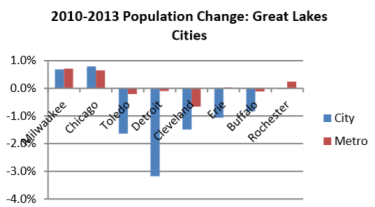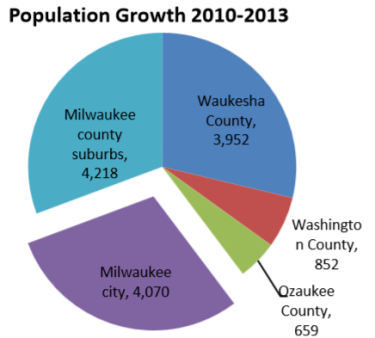The Milwaukee Advantage
Why is population growth here better than in most Great Lakes states?
The Census Bureau recently released its 2013 population estimates for cities. When combined with earlier estimates for counties and metropolitan areas, these tell a continuing story of the challenges faced by cities along the Great Lakes.
Of the eight largest Great Lakes metropolitan areas, only Milwaukee and Chicago saw population growth in the city itself. As can be seen, population shrank in five of the other six cities (Rochester was essentially flat). In those cities, the historical trend of movement from city to suburbs continued, so that total metropolitan population was flat. Although not shown here, the same pattern appeared in smaller cities along the Great Lakes, including those in Wisconsin.
Growth in the Milwaukee area, although low by national standards, was distributed widely. About 60 percent of the increase occurred in Milwaukee County, evenly split between the city and its suburbs. The other 40 percent took place in the so-called “WOW” counties—Waukesha, Ozaukee, and Washington.
The city’s growth comes despite well-publicized challenges, including homes that have been abandoned or foreclosed, a new state law abolishing residency requirements for municipal employees, and continued concern about school quality.
For the Milwaukee area, these results can be viewed from either a “glass half full” or a “glass half empty” viewpoint. Both pessimists and optimists can see support for their positions:
For pessimists, Milwaukee only does well only when compared to the generally weak performance of other Great Lakes cities. The Milwaukee area’s growth of 0.8 percent looks pretty weak when compared to national growth of 2.2 percent.
The weak performance of all Great Lakes cities suggests there’s a regional problem here. Has the previous success of these cities helped create a culture that resists adapting to a changed environment?
In the past, low-cost lake transportation of raw materials such as iron ore meant that manufacturers clustered along the lakes. As global supply chains became more efficient this advantage seems to have become less and less important compared to labor costs when it comes to mass production. Yet governmental efforts to boost the regional economy have still concentrated on lowering manufacturing costs, such as Wisconsin’s very favorable tax treatment of manufacturing.
John Torinus and Tom Hefty have argued that this financial support for manufacturing comes at the cost of supporting other industries that are creating more jobs, such as information services. In addition, this emphasis on reducing the costs of manufacturing could reflect nostalgia for old-style mass production, rather than for manufacturing that competes on responsiveness, innovation, and flexibility.
For optimists, the more positive growth for Milwaukee would imply that its emphasis on competing to create an urban lifestyle is starting to bear fruit. Why are Chicago and Milwaukee doing better than the other Great Lakes cities? One possibility is that both cities are ahead of their peers when it comes to quality of life. For instance, the other cities allowed most of their lake front to be devoted to manufacturing or warehouses.
Increasingly, it appears, success will be based on whether a city creates the kind of environment that attracts well-educated people. There is growing evidence that efforts to attract innovative companies have it backwards: rather than concentrating on attracting the companies, regions should concentrate on creating an environment that will attract the people who years later will start the companies that then attract the people these companies will want to hire.
Time will tell whether the reversal of the previous trend towards hollowing out of the core city will continue over time or turn out to be a temporary phenomenon that will end as the economy strengthens. But what’s happening in Milwaukee does seem consistent with trends around the country showing the increased popularity of cities that offer an urban lifestyle.
Data Wonk
-
Life Expectancy in Wisconsin vs. Other States
 Dec 10th, 2025 by Bruce Thompson
Dec 10th, 2025 by Bruce Thompson
-
How Republicans Opened the Door To Redistricting
 Nov 26th, 2025 by Bruce Thompson
Nov 26th, 2025 by Bruce Thompson
-
The Connection Between Life Expectancy, Poverty and Partisanship
 Nov 21st, 2025 by Bruce Thompson
Nov 21st, 2025 by Bruce Thompson























Just speculating here, but Milwaukee is pretty built out. Some of the other faster growing cities are much larger geographically with more buildable area. Milwaukee and other Great Lakes / Ohio Valley cities are between 50 and 100 square miles. Many cities outside the Great Lakes and coasts are mucher larger and less dense. Milwaukee and the county are pretty dense population centers with mostlt in-fill opportunities. Unless household size increases, population will not increase dramatically.
Milwaukee has also led the region in Hispanic population growth. Outside of Chicago, Milwaukee has the largest percentage of Hispanics in the Great Lakes. This has helped to minimize population losses as well.
Whether Milwaukee gains or population or stabilizes, what really concerns me is the anemic growth of the metro area relative to the rest of the country. This is the discussion that needs to take place. This is an apples to apples comparison. Milwaukee is a favorite target on many in the State and region. But as an objective observer, Milwaukee is holding its own and even outperforming its peers, while our metro area is being outperformed. Why? WCD and others constantly comment on how misguided the city is, but its the suburbs / region that are falling behind. What are they not doing? Do they have mis-placed priorities? Is it cultural?
The City knows what it needs to do and are working towards those objectives. We need to continue to create the urban environment that draws and retains people and industry. Milwaukee is unique and we cannot let outside influences dictate what we can and cannot do.
Don’t we really need to look at the demographics of the group growing. This is especially important in the economic demographic. I think the middle class continues to move out (although not at the huge rates of the past) and the increase is in people with fewer economic resources.
I’m sure this is all true, but its a bit of a canard to simply frame the story around cities bordering the Great Lakes. Click the map a bit west and somewhat south and you see cities as far from Milwaukee as Buffalo and Rochester doing much better population-wise and economically: Columbus, Indianapolis, Madison, Des Moines, Omaha.
As a hometown boy, I like being an optimist about Milwaukee. But I also like my optimism grounded in the fullness of reality.
Oh, and I TOTALLY agree with attracting people, who will then start companies or attract companies. Spot on from where I sit here in San Francisco.
Need to know who makes up the growing population. Are they people with resources or people with few resources.
I think we’re the City is at crucial stage. Young people are moving into the City, but will they stay once they get married or have kids? I think that many will not, but a significant amount might just stay if they can create change in the way services like education are delivered. If not, they’ll be gone.
For SF Scott: Columbus, Indianapolis, Madison, and Des Moines are all state capitals and Columbus and Madison also house their state’s flagship university. Those factors generate many thousands of stable, well-paying jobs as well as supplier firms. This has helped them become about as recession proof as a city can be.
Thanks, Mark. I get the impact of being a state capital or home to a flagship state university on the economy, but this article is, specifically, about population growth. Being a state capital has not had a positive impact on population for the period in question.
From a 2012 Des Moines Register article:
“Des Moines’ population is growing at a faster rate than the state as a whole and the region, bucking a national trend that sees state capitals shrinking or stagnant, according to newly released U.S. Census Bureau estimates.
Des Moines’ estimated population on July 1, 2012, was an estimated 1.6 percent greater than the figure reported in the 2010 census. That’s better than the 0.91 percent population growth for the state and 0.58 percent growth in the Midwest, the data released last week show.
Nationally, nine capitals shrank in the same time period, and half lagged behind the growth rates of their regions.”